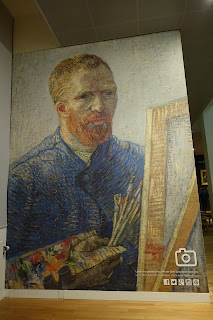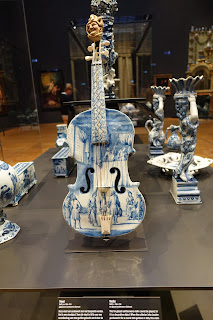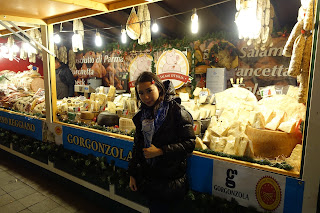 |
| Beaux-Arts architecture |
This is my second time to Paris, it is indeed a fashion capital, artistic, romantic, cultural and historical city, it is one of my favorite city.
I was so happy to visit my friend who stay in Paris with her french husband, they have a cute baby now (was still pregnant that time). I just hope I can go to Paris again to see their baby now :).
A must go to MAMA shelter, get some yummy pizzas, the bar is very nice as well. I love their interior design, a huge terrace stretching along the other side of the space is made to stand up to the elements. It's always perfect for a cigarette break. No lounge music but Rap and R&B. On thursdays, fridays and saturdays, artists from around the world come here to perform live at Mama.
Mama Shelter Paris
Address:
109 Rue de Bagnolet, 75020 Paris, France
http://www.mamashelter.com/en/paris/
I'm a wine lover, wherever bar or restaurant I go, always have a glass of wine with me. :D
MUST VISIT - Catacombs (underground cemetery)
The name of ‘Catacombs’ was given to this ossuary in reference to the Catacombs of Rome, a name originally given to an ancient cemetery situated not far from the Appian Way. The Cemetery of the Innocents (near Saint-Eustache, in the area of Les Halles) had been in use for nearly ten centuries and had become a source of infection for the inhabitants of the locality. After numerous complaints, the Council of State decided, on November 9th 1785, to prohibit further use of the Cemetery of the Innocents and to remove its contents.
Disused quarries were chosen to receive the remains; the City of Paris had in fact just completed a general inspection of the quarries, in order to strengthen the public highways undermined by them. Building work was done on the “Tombe-Issoire” quarry, using large quantities of stone, strengthening the galleries and completed by digging out a staircase, flanked by a well into which the bones could be thrown.
The transfer of the remains could begin after the blessing and consecration of the site on April 7th 1786, and it continued until 1788, always at nightfall and following a ceremony whereby a procession of priests in surplices sang the service for the dead along the route taken by the carts loaded with bones, which were covered by a black veil. Then, until 1814, the site received the remains from all the cemeteries of Paris.
Since their creation, the Catacombs have aroused curiosity. In 1787, the Count d’Artois, the future Charles X, made the descent, along with Ladies of the Court. The following year a visit from Madame de Polignac and Madame de Guiche is mentioned. In 1814, Francis I, the Emperor of Austria living victoriously in Paris, visited them. In 1860, Napoleon III went down with his son.
The Paris Catacombs re-opened on June 14th 2005, after several months of closure for building work. The lighting has been adjusted, the vaults strengthened and the walls of bones put back.
** I felt impressive and made me think about life. We cannot find anything that is permanent. Impermanence is more than an idea. It is a practice to help us touch reality.
FASHION CONCEPT:
Fashion is everywhere. Parisian style is just lovely, perhaps it is a concept. I heard almost everyone has Paris dream.
Elegance is an attitude. It is not only how you dress, it is more on how you carry yourself.
You're the one who wear the dress, show the essence of the design. Time to make an impact if you dare. :) Well,
fashion is just so fun.
LA RHUMERIE : is offered to Rum lovers and Caribbean culture.
Address: 166 Boulevard Saint-Germain, 75006 Paris, France
La Rhumerie, as you may well have gathered, specialises in all things rum. This historic Left Bank bar dates back to the 1930s, when it was created by Joseph Louville, and his passion for all things rum has been continued. The place still looks much as it did. It’s fairly basic but that’s part of its charm. The nice, light room has raw terracotta walls and is decked out in a lot of wicker. But it’s the rums you come here for. The collection is huge. They have a vast array to choose from, both small batch and premium brands. Tasting flights are available and they also boast a huge selection of rum-based cocktails to explore. There are mojitos of every conceivable colour and flavour, daiquiris and zombies, coladas and mai tai's, punches and warm rum drinks for cold nights. They also serve a selection of Caribbean snacks to pair with your drinks, fish patties and plantain chips, Caribbean codfish fritters and Creole platters. Their Creole brunch dishes are also worth checking out and we’re betting their rum baba will be a good one. The bar tenders are on hand to advise and guide you through the drinks list and the place has a warm and lively atmosphere.
Parisian Dining:
Escargot (French for snail) and steak with wine are my all-time favourites! and Champagne, of course! :p
MERRY XMAS!
 Always love this festive season, full of joy and peace, and I was blessed to celebrate this season during winter, it is so much different from celebrating in Singapore.
Always love this festive season, full of joy and peace, and I was blessed to celebrate this season during winter, it is so much different from celebrating in Singapore.Champagne and wines are very common in France, how I wish we have this price in Singapore. :) As a champagne and wine lover, nothing can compare with some good glasses of wines, especially with the food.
And compare to beer or liquor, wine has less calories. In general, white wines tend to be lower in alcohol and calories than reds. While light whites have around 140 calories or less per six-ounce glass, a light red has between 135 to 165 calories, while a higher-alcohol red like Pinot Noir or Shiraz can have up to 200 in a glass.
 |
| Arc de Triomphe |
 |
| Champs-Élysées |
The Arc de Triomphe de l'Étoile is one of the most famous monuments in Paris. It stands in the centre of the Place Charles de Gaulle, at the western end of the Champs-Élysées.
LA GRANDE ROUE DE PARIS FERRIS WHEELS
 La Grande Roue: located at Place de la Concorde, at the entrance to the
Tuilerie Gardens, you can enjoy a ride with a breathtaking view at
60-meters-high, Paris lying at your feet.
La Grande Roue: located at Place de la Concorde, at the entrance to the
Tuilerie Gardens, you can enjoy a ride with a breathtaking view at
60-meters-high, Paris lying at your feet.The history of the big wheel goes back to the beginning of the last century. Back then, the Eiffel tower wasn’t the only attraction of the World’s fair, l’exposition universelle. A huge Ferris wheel of 100 meters was erected and stayed until 1920. It’s said that its passenger cars were so large that, once they were removed from the Wheel, they were used as homes for French families in the regions devastated by World War II.
PALAIS GARNIER
The Palais Garnier is a 1,979-seat opera house, which was built from 1861 to 1875 for the Paris Opera.
A symbol of Paris, is an architectural masterpiece.
JARDIN DU LUXEMBOURG
Situated on the border between Saint-Germain-des-Prés and the Latin Quarter, the Luxembourg Gardens, inspired by the Boboli Gardens in Florence, were created upon the initiative of Queen Marie de Medici in 1612. The gardens, which cover 25 hectares of land, are split into French gardens and English gardens. Between the two, lies a geometric forest and a large pond. There is also an orchard with a variety of old and forgotten apples, an apiary for you to learn about bee-keeping and greenhouses with a collection of breathtaking orchids and a rose garden.
 | ||||||||||
| yummy kebab for lunch |
CATHEDRALE NOTRE DAME DE PARIS
always super long queue, but it is one of the symbol of Paris, must visit, I came here 3 years ago, so this round I would just skip.
It was quite crazy to drink beer outside a bar, during winter. But I quite like it. :p
Super yummy steak with wine again, as usual, my all time favourite.
NIGHT LIFE
Party is definitely happening in PARIS. Great music!
PALACE OF VERSAILLES


Gardens and Park of the Château
PALACE OF VERSAILLES


The Château de Versailles, which has been on UNESCO’s World Heritage
List for 30 years, is one of the most beautiful achievements of
18th-century French art. The site began as Louis XIII’s hunting lodge
before his son Louis XIV transformed and expanded it, moving the court
and government of France to Versailles in 1682. Each of the three French
kings who lived there until the French Revolution added improvements to
make it more beautiful.
The château lost its standing as the official seat of power in 1789 but
acquired a new role in the 19th century as the Museum of the History of
France, which was founded at the behest of Louis-Philippe, who ascended
to the throne in 1830. That is when many of the château’s rooms were
taken over to house the new collections, which were added to until the
early 20th century, tracing milestones in French history.
Gardens and Park of the Château
From the central window of the Hall of mirrors the visitor look down on
the grand perspective that leads the gaze from the Water Parterre to the
horizon. This original perspective, which preceded the reign of Louis
XIV, was developed and prolonged by the gardener André Le Nôtre by
widening the Royal Path and digging the Grand Canal. This vast
perspective stretches from the façade of the Château de Versailles to
the railings of the park.
Since 1992, the gardens have been gradually replanted, and after the devastating storm of December 1999, the work speeded up to such an extent that quite a few sections have already been restored to their original appearance.
Since 1992, the gardens have been gradually replanted, and after the devastating storm of December 1999, the work speeded up to such an extent that quite a few sections have already been restored to their original appearance.

Last night in Paris. We might have some unexpected experience in every trip we have. We might meet new friends, new things that we have never seen before, new food, etc.
But the most important is - find ourselves. Open our hearts and eyes, breathe deeply, live deeply, enjoy the moments, every single moment...
You will realize, nothing is more precious than being in the present moment, fully alive and fully aware.





























































